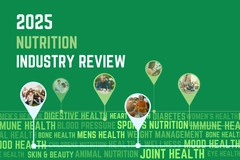Dairy protein diversification: Innovators whey up health and wellness opportunities as consumer demands evolve

08 Dec 2022 --- Consumers are increasingly turning to dairy proteins for gut health, healthy aging benefits and sports recovery as the segment centers around health and wellness innovation. NutritionInsight speaks to industry experts at Kerry, Carbery, the US Dairy Export Council (USDEC) and Arla Foods Ingredients about the latest trends driving the sector forward, featuring high-protein solutions and whey protein R&D.
Irish food company Kerry predicts that high-protein will take market share from indulgent desserts in the medium term. “Affordable treats will continue to grow even during a time of reduced consumer spending, where people will treat themselves in a small way while also seeking improved health and nutrition benefits in products,” explains Huey van Vliet, commercial director at Kerry.
Meanwhile, natural cheese producer Carbery forecasts that dairy proteins will continue to command a premium space. “Consumers will focus more on transparent, sustainable and efficient food systems when choosing ingredients and products,” says Sarah O’Neill, global strategy lead at Carbery Group.
Sports and clinical nutrition
According to Carbery, new functional ingredients and bioactive-based whey proteins will create growth and added value in the sector.
“Ongoing scientific research around the additional health-promoting benefits of dairy proteins and clinically validated ingredients will continue to drive the growth and demand of dairy proteins across various demographics and product categories,” says O’Neill.
With high-intensity training (HIIT) based exercises becoming more popular, the company has developed Optipep 4Power, a hydrolyzed ingredient clinically proven to increase mean power output and reduce fatigue index when taken before high-intensity exercise. Consumers are looking for global flavor adventures with protein levels and clean labels.
Consumers are looking for global flavor adventures with protein levels and clean labels.
Terri Rexroat, vice president of global ingredients marketing at USDEC, elaborates: “As part of a high-protein diet, dairy proteins promote muscle repair and recovery after exercise, builds lean muscle when combined with regular resistance exercise, helps maintain a healthy weight, curbs hunger and maintains muscle mass as people age.”
Moreover, consumers are looking for bolder, more global flavors with protein levels, clean labels and price in mind.
“Global demand for dairy proteins is growing as awareness of protein benefits expands. Ongoing technical innovations have allowed US suppliers to become increasingly specialized in producing dairy proteins to meet varying protein levels, functional properties and other specifications,” Rexroat explains.
Functional properties
Milk protein ingredients are used for their nutritional and functional properties. For example, higher-protein milk protein concentrates (MPCs) provide protein enhancement and a clean dairy flavor without adding significant levels of lactose to food and beverage formulations.
“MPCs also contribute valuable minerals such as calcium, magnesium and phosphorus, which may reduce the need for additional sources of these minerals,” explains Rexroat.
“In Asia, protein throughout the day for healthy aging is an important message, especially for countries with rapidly aging populations.”
USDEC’s prototype mango protein pudding is made with whey protein concentrate (WPC) 80 and skim milk powder containing 15.8 g of protein per 150 g serving. The ready-to-mix format features reduced sugar content.
According to O’Neill, the COVID-19 pandemic accelerated the demand for functional ingredients to support immune health. “In general, busier lifestyles drive the demand for more convenient delivery formats like protein bars, gummies, gels and ready-to-drink (RTD) beverages,” says O’Neill.
Post-pandemic, consumers are looking to find meal solutions that fulfill their nutritional needs while also not taking too much time from their busy lives. As such, many are turning to the long-dormant but now rapidly expanding complete foods market.
Health-conscious consumers
The growing consumer tendency toward health consciousness means shoppers are more open to high-protein versions of their favorite products. “Some 80% of consumers now say they’re interested in protein,” says Katrine Helene Fruergaard Holm, industry marketing manager for dairy and bakery at Arla Foods Ingredients.
“There’s also high demand for novelty – hence, for example, the continuing popularity of drinking yogurts and clear protein drinks in the healthy beverage space,” explains Fruergaard Holm.
However, taste and texture are still a priority for consumers. “When so many market sectors are crowded, products have to offer appealing taste, texture and mouthfeel to be successful. The great thing about dairy proteins is that they can meet all these needs,” says Fruergaard Holm.
According to O’Neill, consumers have become increasingly health conscious and educated about the importance of good quality protein in their diet to help combat illness and injury.
“They seek protein ingredients with additional benefits such as rapid absorption and easier digestion that are backed by science and clinically validated,” she says. Milk protein concentrates valuable minerals such as calcium, magnesium and phosphorus in the diet.
Milk protein concentrates valuable minerals such as calcium, magnesium and phosphorus in the diet.
Areas of growth
With aging populations becoming more prevalent, healthy aging is a space experiencing significant growth. “In China, the population is set to grow by 25 million people by 2030. The demographic changes are significant,” outlines Van Vliet at Kerry.
According to the company, the predicted number of people under four will drop by 13 million in 2030, while the figures for over 50-year-olds will increase by 100 million.
“This is creating a segment of older but active consumers looking to increase their daily protein consumption to increase their health and wellness. Kerry is in a great position to assist customers in meeting the needs of these consumers with its portfolio of proactive health ingredients,” Van Vliet continues.
In Latin America, food processors and manufacturers are focused on the use of milk powders and dairy proteins in native Mexican cheeses and the use of milk powder, proteins and permeate in bakery applications.
USDEC’s prototype Savory, Soft Protein Pretzel combines protein and permeate for a better-for-you version of a popular global snack. Made with WPC 80, milk permeate and unsalted butter, this dairy-based formulation reduces sodium by 73% compared to a traditional pretzel.
Whey protein
Over the past decade, the number of tracked new products using permeate has soared globally, according to USDEC’s research. In 2021, a record-breaking 752 products were launched using permeate with properties such as flavor enhancement, sodium reduction, nourishing minerals, browning and cost savings.’
Rice and wheat noodles made with WPC and MPC can increase protein by 35% to 125%, including improved functionality. “Dairy proteins slow down the development of the stickiness of wheat flour noodles after boiling, which is a plus for preserving the quality of takeaway and delivery dishes,” Rexroat explains.
In addition to a protein boost, WPC provides textural characteristics, prevents moisture loss and contains branched-chain essential amino acids to support nutrition. “Milk permeate provides salty characteristics so added salt may be reduced, is simply labeled as dairy product solids, improves surface browning and contains important mineral nutrients such as calcium, phosphorus, magnesium, sodium and potassium,” Rexroat continues.
Consumer demands for good tasting, nutritious, shelf-stable products that can easily be consumed on-the-go create development opportunities for heat-stable whey proteins, suitable for UHT, RTD formats and functional whey proteins to help maintain softness in protein bars and snacks over shelf life.
“Interest in fermented dairy protein ingredients that can support microbiome diversity is also steadily increasing and influencing new product development pipelines,” O’Neill explains.
Carbery produces whey protein hydrolysates for use in infant, performance and clinical nutrition. “We focus on maximizing the nutritional and health benefits of whey protein across a wide range of applications, including powdered supplements, RTD beverages, gels and bars,” says O’Neill.
Promising geographies for milk protein As HIIT-based exercise becomes more popular, a high-protein diet assists in muscle recovery.
As HIIT-based exercise becomes more popular, a high-protein diet assists in muscle recovery.
Asia, the Middle East and Latin America are among the regions that represent promising untapped potential for health and wellness innovations, according to USDEC.
“Whey proteins and permeate can help food formulators offer clean label, better-for-you versions of favorite traditional local foods, tailored to different dietary habits while offering the same great taste,” says Rexroat
“Global food and beverage companies that already use dairy ingredients are convinced of their value, and now it’s time for everyone else to experience this firsthand. The sky’s the limit when it comes to growing global opportunities and diverse innovation possibilities with dairy.”
USDEC partners with local experts and organizations in the Asian, Middle Easten and Latin American markets to inspire local use and consumption of dairy ingredients in a way that delivers on market needs and consumer lifestyle desires.
R&D in dairy proteins
The market for bars – both confectionery and sports nutrition – is increasingly crowded, prompting manufacturers to innovate to stand out.
“We’ve just launched a new concept that allows brands to raise the protein content of every part of their bars, including the mass, filling and coating, without increasing size or compromising on taste or texture,” explains Fruergaard Holm.
The concept is based on quality whey and milk protein ingredients from Arla’s Lacprodan range and ensures that rich chocolate mass retains its flavor and softness throughout its shelf life.
Meanwhile, Kerry has pioneered Hyfoama, an innovative solution based on dairy as an alternative to egg white in selected applications such as sugar confectionery, aerated desserts and beverages.
“Considering the current market concerns around egg availability, our technology provides an excellent dairy-based alternative where egg white is used for aeration,” explains Van Vliet.
Also, Carbery has developed a range of highly heat-stable Optipep 8008 whey proteins for ultra-high temperature processed oral nutritional supplements for the clinical nutrition market. It can easily be mixed with boiling water to create high-protein, low-sugar hot chocolates, coffees and lattes.
By Inga de Jong












